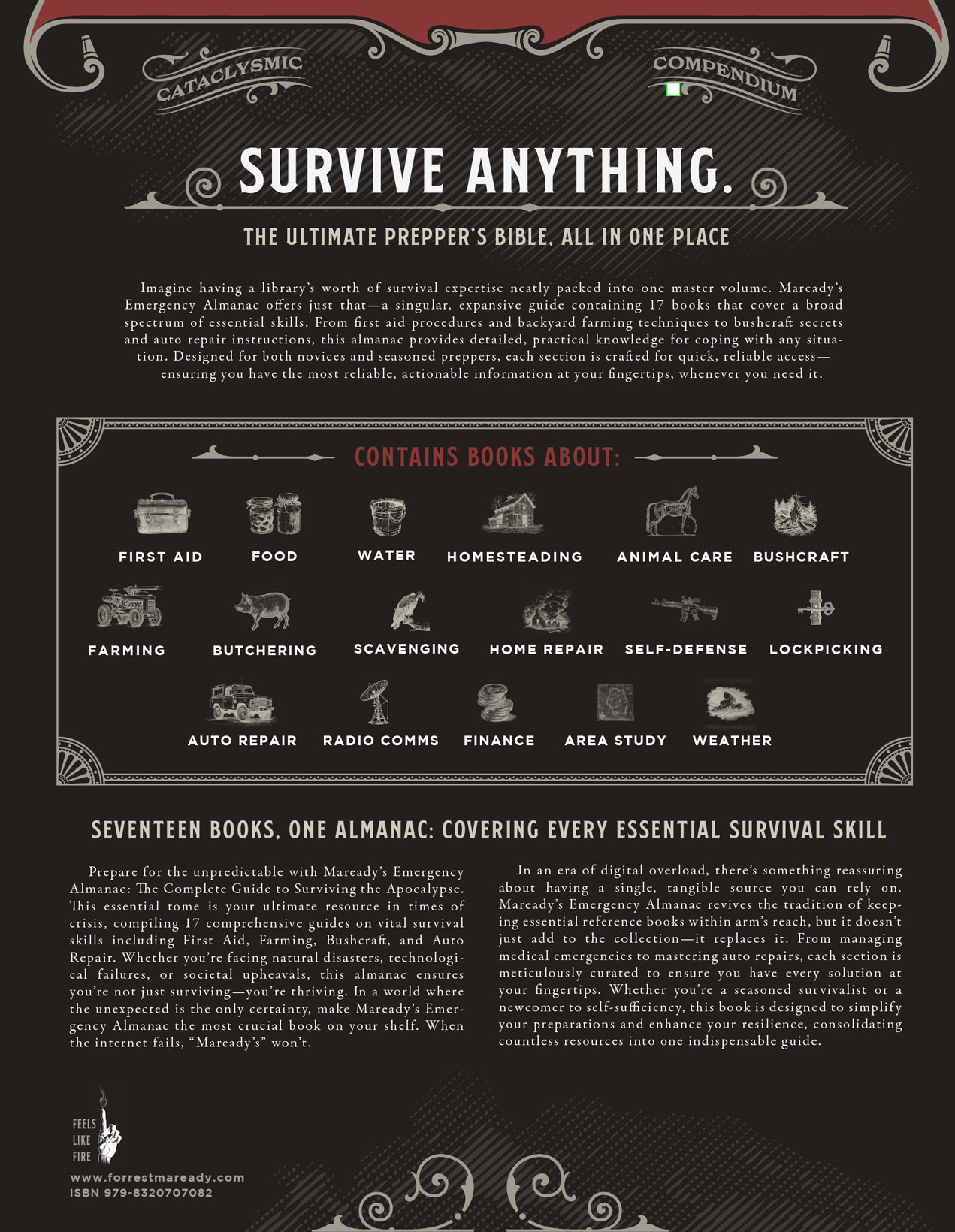
Prepare for the unpredictable with Maready’s Emergency Almanac: The Complete Guide to Surviving the Apocalypse. This essential tome is your ultimate resource in times of crisis, compiling 17 comprehensive guides on vital survival skills including First Aid, Farming, Bushcraft, and Auto Repair. Whether you’re facing natural disasters, technological failures, or societal upheavals, this almanac ensures you’re not just surviving—you’re thriving. In a world where the unexpected is the only certainty, make Maready’s Emergency Almanac the most crucial book on your shelf. When the internet fails, “Maready’s” won’t.
Imagine having a library’s worth of survival expertise neatly packed into one master volume. Maready’s Emergency Almanac offers just that—a singular, expansive guide containing 17 books that cover a broad spectrum of essential skills. From first aid procedures and sustainable farming techniques to bushcraft secrets and auto repair instructions, this almanac provides detailed, practical knowledge for coping with any situation. Designed for both novices and seasoned preppers, each section is crafted for quick, reliable access—ensuring you have the most reliable, actionable information at your fingertips, whenever you need it.


In an era of digital overload, there’s something reassuring about having a single, tangible source you can rely on. Maready’s Emergency Almanac revives the tradition of keeping essential reference books within arm’s reach, but it doesn’t just add to the collection—it replaces it. From managing medical emergencies to mastering auto repairs, each section is meticulously curated to ensure you have every solution at your fingertips. Whether you’re a seasoned survivalist or a newcomer to self-sufficiency, this book is designed to simplify your preparations and enhance your resilience, consolidating countless resources into one indispensable guide.
When digital connectivity can be as fragile as it is essential, Maready’s Emergency Almanac stands as a steadfast resource. This portable tome encapsulates the vast array of useful knowledge typically found online, yet is impervious to the vulnerabilities of digital devices. Unlike smartphones or tablets, Maready’s requires no recharging, remains unaffected by EMP attacks, and provides uninterrupted access to crucial information in any scenario. Whether you're deep in the wilderness or facing a power outage at home, this almanac ensures that expert knowledge on survival and self-sufficiency is always within reach, no signal necessary.

Maready’s Emergency Almanac isn't just extensive in scope—it's also impressive in size. At 8.5" x 11", this almanac is significantly larger than standard books, designed to accommodate its vast array of survival knowledge comfortably. Spanning +580 pages, it's about half the length of an average King James Bible, making it a substantial resource that is both thorough and detailed. Each page is packed with essential information, formatted to be easily accessible and readable. Whether kept at home or taken on the go, this almanac is a tangible fortress of knowledge, ready to guide you through any crisis with confidence.


This almanac is not just a book, but a comprehensive survival toolkit, encapsulating what would amount to hundreds of dollars worth of individual guides into one authoritative volume. Each of the 17 books within it offers expert knowledge and practical advice on essential survival skills that could prove indispensable in an emergency. The cost of this single volume is a fraction of what you would spend gathering this wealth of information separately. Invest in your safety and peace of mind with Maready’s, knowing that you possess a resource that can guide you through any challenge, now and in the future.


This almanac isn't just a book, but a comprehensive survival toolkit, encapsulating what would amount to hundreds of dollars worth of individual guides into one authoritative volume. Each of the 17 books within it offers expert knowledge and practical advice on essential survival skills that could prove indispensable in an emergency. The cost of this single volume is a fraction of what you would spend gathering this wealth of information separately. Invest in your safety and peace of mind with Maready’s, knowing that you possess a resource that can guide you through any challenge, now and in the future.

Available through in print only through Amazon or directly through the editor's website. Get your copy now while the internet still works!